Suivi et évaluation
La plupart des défis liés au suivi et à l’évaluation, comme la quantité insuffisante d’investissements et le manque de capacités, ne sont pas spécifiques à l’assistance monétaire, mais ceux qui le sont concernent principalement le suivi des résultats des transferts non affectés. La flexibilité des transferts monétaires peut compliquer la définition d’indicateurs de résultats appropriés, qui pourraient impliquer un mélange d’indicateurs spécifiques au secteur et transversaux. En parallèle, il existe des limitations au moment de collecter des données précises sur la manière dont les transferts monétaires sont dépensés.
Les signataires du Grand Bargain se sont engagés à garantir que des mécanismes de suivi et d’évaluation pertinents des transferts monétaires soient en place, et à assurer une meilleure compréhension des coûts, avantages, impacts et risques de cette modalité par rapport à d’autres. En partant de cet engagement, le chantier du Grand Bargain sur les transferts monétaires a établi plusieurs points d’action, dont le développement d’indicateurs de résultats communs pour les transferts monétaires à usages multiples, et des indicateurs pour l’analyse de l’optimisation des ressources. L’analyse systématique de l’optimisation des ressources a été rendue difficile par plusieurs facteurs, dont un manque d’approches approuvées, le besoin en données sur les résultats en termes de qualité et le caractère intensif de l’analyse.
Priorités actuelles
Dans le cadre des engagements du chantier du Grand Bargain sur les transferts monétaires, le CALP Network a co-dirigé (avec l’USAID et CRS) la mise au point d’indicateurs de résultats des transferts monétaires à usages multiples. Le projet à tester est actuellement disponible en anglais, espagnol et français, via la bibliothèque.
Initiatives associées
Contenu présenté

Indicateurs de résultats des transferts monétaires à usages multiples : Projet final à tester
Guides et outils
Les indicateurs présentés dans ce document se concentrent sur les principaux objectifs des TMUM humanitaires et sur les résultats auxquels les transferts monétaires à usages multiples peuvent le plus fortement contribuer. (Par exemple, certaines interventions en TMUM visent à relier les personnes aux systèmes de protection sociale après la fin du TMUM; mais nous n’avons pas inclus...

Monitoring 4 CTP: Monitoring Guidance for CTP in Emergencies
Guidelines and Tools
This guidance provides a central resource to promote a common understanding of the most important monitoring considerations for humanitarian projects using cash transfer programming (CTP). The primary audience for this guidance is field-level practitioners, from organisations directly involved in the design, implementation, monitoring, and accountability of projects using cash and vouchers...
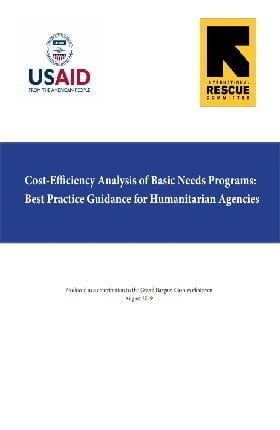
Cost-Efficiency Analysis of Basic Needs Programs: Best Practice Guidance for Humanitarian Agencies
Guidelines and Tools
The Efficiency, Effectiveness and Value for Money Sub-Workstream is pleased to share the final output on Cost-Efficiency Analysis of Basic Needs Programs: Best Practice Guidance for Humanitarian Agencies (attached).
Cost-efficiency analysis estimates the ratio of program costs to outputs created, allowing you to compare cost-per-output for programs which all produced the same output. Such...
Thematic lead
Contenu récent

Cash and Voucher Assistance Guidelines for Lao PDR
Guidelines and Tools
Cash and voucher assistance is becoming increasingly popular in Lao PDR in delivering humanitarian assistance, rehabilitation and development focused projects. In supporting the cash and voucher assistance agenda in Lao PDR, the Cash Working Group was established as a working group for local and regional...
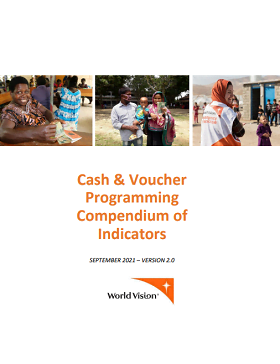
WVI Cash and Voucher Programming Indicator Compendium
Guidelines and Tools
This indicator compendium was designed to support World Vision field offices to design and monitor quality cash and voucher programmes. Specifically, the compendium will enable colleagues responsible for designing, implementing and monitoring cash and voucher programming to select appropriate indicators...

Safer Cash Toolkit (Français)
Guides et outils
La trousse pour une gestion sûre des espèces a été conçue dans
le but d’apporter une solution au problème de manque de données
pour l’évaluation systématique des risques encourus par les individus
qui reçoivent et utilisent l’assistance en espèces de programmes
humanitaires. Cette trousse...
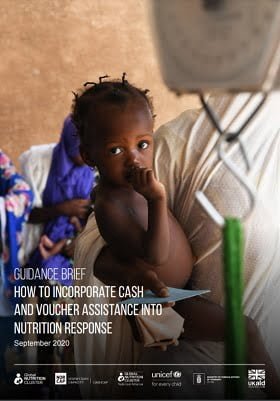
How to Incorporate Cash and Voucher Assistance into a Nutrition Response
Guidelines and Tools
There is a growing recognition that Cash and Voucher Assistance (CVA), i.e. the provision of cash transfers and vouchers to targeted beneficiaries, can contribute to improving maternal and child nutrition by impacting on the underlying determinants of adequate nutrition. The main purpose of this Guidance...

Perception survey of aid recipients in Somalia
Report
Before the first case of COVID-19 was officially confirmed on 16 March 2020, Somalia was in a state of emergency resulting from the worst locust infestation in 25 years. With food supplies already under threat, the infestation was exacerbated by heavy floods, which not only displaced half a million...
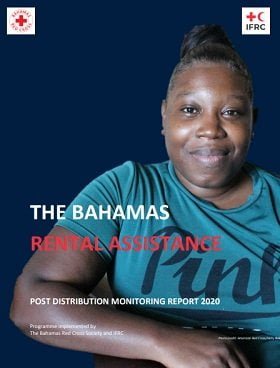
The Bahamas, Rental Assistance, Post Distribution Monitoring Report 2020
Report
This Post Distribution (PDM) Report presents the findings of the Rental Assistance programme in Grand Bahama implemented by The Bahamas Red Cross Society (BRCS) with support of the International Federation of Red Cross and Red Crescent Societies (IFRC). The programme sought initially to provide a...

Evidence building for cash and markets for WASH in emergencies
Webinar recording
This webinar was co-hosted by the Global WASH Cluster, Pro-WASH and the CALP Network in December 2020. The webinar presented findings from a systematic review (“Evidence building for cash and markets for WASH in emergencies”) conducted by the Global WASH Cluster (GWC), which examined how WASH actors...
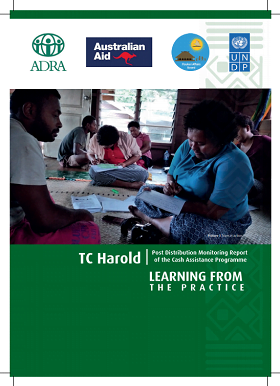
CVA TC Harold Response
Report
ADRA Fiji mobilized a team to monitor the efficiency and impact of cash assistance distributed by the organization in partnership with the I-Taukei Affairs Board (TAB) and their respective local partners in the island to respond to TC Harold. At the height of the intervention the agency distributed F$...

Cash Barometer Nigeria
Case Study
After more than a decade of conflict and violent insurgency by the non-state armed group Boko Haram, some 7.9 million people in Nigeria’s Borno, Adamawa and Yobe states (collectively known as the BAY states) were expected to be in need of humanitarian assistance in 2020. Since the onset of Covid-19,...

Transferts monétaires en faveur de l’éducation en situation d’urgence – Rapport de synthèse et directives
Rapport
Le Cluster Education Global a publié en 2019 Le Rapport de synthèse et les directives sur les transferts monétaires en faveur de l’éducation en urgences. Le document a été développé avec l’appui financier de ECHO et l’appui technique de CashCap. Ces recherches se concentrent sur les...

Livelihood Transition of the ESSN | Capacity Mapping and Understanding the Potential
Report
The Emergency Social Safety Net (ESSN) programme is reaching more than 1.7 million refugees with monthly cash assistance to help them cover their basic needs and providing them with freedom of choice while promoting dignity. On the other hand, the project aims to increase affected people’s economic and...
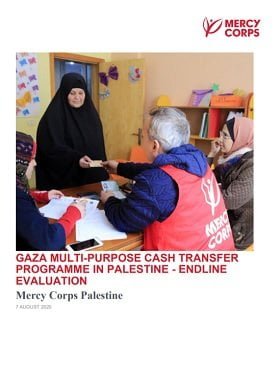
Gaza Multi-Purpose Cash Programme: Endline Evaluation
Report
This report presents the key findings of the pilot Gaza Multi-Purpose Cash Program (GMPC) implemented by Mercy Corps Palestine in the Gaza Strip during 2019-20. The aim of the programme was to allow 1,227 poor and food insecure households to meet their varied basic needs, by delivering three cash...
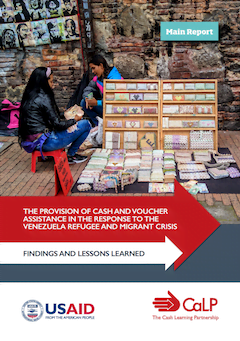
The Provision of Cash and Voucher Assistance in the Response to the Venezuela Refugee and Migrant Crisis: Findings and lessons learned – Main report
Report
This study, for which data was compiled between March and April 2020, seeks to document lessons and good practices in the delivery of CVA in Ecuador and Colombia by humanitarian organisations and governments, in response to migrants and refugees from Venezuela. The purpose of this analysis is...
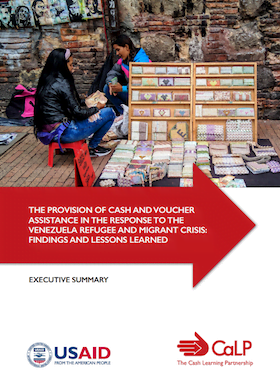
The Provision of Cash and Voucher Assistance in the Response to the Venezuela Refugee and Migrant Crisis: Findings and lessons learned, Executive summary
Report
This study, for which data was compiled between March and April 2020, seeks to document lessons and good practices in the delivery of CVA in Ecuador and Colombia by humanitarian organisations and governments, in response to migrants and refugees from Venezuela. The purpose of this analysis is...

Presentation for the CALP Network’s webinar on remote registration and verification in the COVID-19 response
Presentation
Watch the webinar recording here Speaker presentations from the CALP Network’s 14 July 2020 webinar on: Peril or pitfalls?: Emerging practices on remote registration and verification in the COVID-19 response Remote CVA programming has been highlighted as a key challenge for the community of practice in...

Cash and Voucher Assistance Case Studies – Yemen and Afghanistan
Report
Evidence and feasibility of cash and voucher assistance (CVA) for sexual and reproductive health services in humanitarian emergencies. There is limited evidence about the effectiveness and feasibility of CVA, and about its overall effect on SRHR outcomes, particularly in humanitarian settings. Therefore,...

Collaborative Cash Delivery Network – Grand Bargain – Collaboration Agreement Accomplishments 2020
Report
The Collaborative Cash Delivery (CCD) Network is pleased to present its achievements against the commitments made by our global members’ CEOs at the 2019 Grand Bargain Summit as part of our global collaboration agreement. We know we are better together, and in this time of increasing pressure on the...

Les transferts monétaires & COVID-19 : Évaluation et suivi des marchés à distance
Blog Post
Alors que les praticiens sur le terrain adaptent leurs programmes au Covid-19, des collègues parmi nos membres et Groupes de Travail sur les Transferts Monétaires identifient un grand nombre de défis. L’objectif de cette série de vidéos conçues est de partager les stratégies pratiques et les...
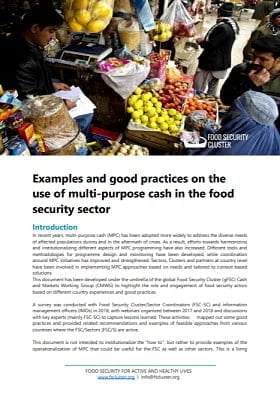
Examples and Good Practices on the Use of Multi-Purpose Cash in the Food Security Sector
Guidelines and Tools
This global Food Security Cluster (gFSC) document was produced by the Cash and Markets Working Group (CMWG) to highlight the role and engagement of food security actors through different country experiences and good practices.
In recent years, multi-purpose cash (MPC) has been adopted more widely to...
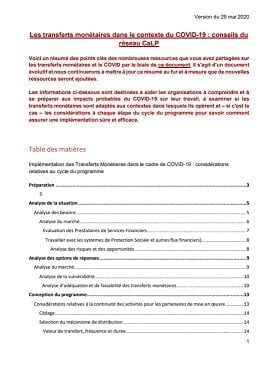
Les transferts monétaires dans le contexte du COVID-19 : conseils du réseau le CALP Network
Guides et outils
Voici un résumé des points clés des nombreuses ressources que vous avez partagées sur les transferts monétaires et le COVID par le biais de ce document. Il s’agit d’un document évolutif et nous continuerons à mettre à jour ce résumé au fur et à mesure que de nouvelles ressources seront...



